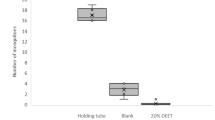Abstract
Cercariae of Schistosoma mansoni approach towards their host’s skin with a chemokinesis. They respond to human skin extracts by inserting shifts between backward and forward swimming and therewith increase the rate of change of direction (RCD). We identified the host attractants by fractionating human skin surface extracts, exposing the fractions and chemicals to the cercariae and recording cercarial swimming by video tracking. The cercariae responded specifically to three skin surface compounds by increasing the frequency of shifts in swimming direction. (1) Free fatty acids. The effectiveness was limited to chain lengths between 10 and 14 carbon atoms in saturated chains and increased by the number of double bonds. (2) Free l-arginine at concentrations as low as 100 nM. (3) Small peptides with terminally located l-arginine at concentrations as low as 50 μM. All chemokinesis stimuli are also involved in subsequent behavioural phases of host invasion: attachment and directed creeping on the skin surface, penetration and navigation within host tissues. The cercariae responded during swimming only to these small molecular water soluble cues and not to cues to which they respond in other behavioural phases of host invasion, but which are unsuitable as chemoattractants due to their chemical properties or distribution within the skin layers. This characterises the chemokinetic responses as adequate adaptation to advance transmission success.
Similar content being viewed by others
References
Austin FG, Stirewalt MA, Danzinger RE (1972) Schistosoma mansoni: stimulatory effect of rat skin lipid fractions on cercarial penetration behavior. Exp Parasitol 31:217–224
Brachs S, Haas W (2008) Swimming behaviour of Schistosoma mansoni cercariae: responses to irradiance changes and skin attractants. Paras Res (in press)
Cunningham DD, Young DF (2003) Measurements of glucose on the skin surface, in stratum corneum and in transcutaneous extracts: implications for physiological sampling. Clin Chem Med Lab 41:1224–1228
Folch J, Lees M, Sloane Stanley GH (1957) A simple method for the isolation and purification of total lipids from animal tissues. J Biol Chem 226:497–509
Grabe K, Haas W (2004) Navigation within host tissues: Schistosoma mansoni and Trichobilharzia ocellata schistosomula respond to chemical gradients. Internat J Parasitol 34:927–934
Granzer M, Haas W (1986) The chemical stimuli of human skin surface for the attachment response of Schistosoma mansoni cercariae. Int J Parasitol 16:575–579
Haas W (1976) Die Anheftung (Fixation) der Cercarie von Schistosoma mansoni. Einfluss natürlicher Substrate und der Temperatur. Zeitschr Parasitenkd 49:63–72
Haas W (1994) Physiological analysis of host-finding behaviour in trematode cercariae: adaptions for transmission success. Parasitology 71:422–431
Haas W (2003) Parasitic worms: strategies of host finding, recognition and invasion. Zoology 106:349–364
Haas W, Haberl B (1997) Host recognition by trematode miracidia and cercariae. In: Fried B, Graczyk TK (eds) Advances in trematode biology. CRC, Boca Raton, pp 197–227
Haas W, Schmitt R (1982a) Characterization of chemical stimuli for the penetration of Schistosoma mansoni cercariae. I. Effective substances, host specificity. Z Parasitenkd 66:293–307
Haas W, Schmitt R (1982b) Characterization of chemical stimuli for the penetration of Schistosoma mansoni cercariae. II. Conditions and mode of action. Z Parasitenkd 66:309–319
Haas W, Granzer M, Garcia EG (1987) Host identification by Schistosoma japonicum cercariae. J Parasitol 73:568–577
Haas W, Haberl B, Schmalfuss G, Khayyal MT (1994) Schistosoma haematobium cercarial host-finding and host-recognition differs from that of S. mansoni. J Parasitol 80:345–353
Haas W, Körner M, Hutterer E, Wegner M, Haberl B (1995) Finding and recognition of the snail intermediate hosts by 3 species of echinostome cercariae. Parasitology 110:133–142
Haas W, Diekhoff D, Koch K, Schmalfuss G, Loy C (1997) Schistosoma mansoni cercariae: stimulation of acetabular gland secretion is adapted to the chemical composition of mammalian skin. J Parasitol 83:1079–1085
Haas W, Grabe K, Geis C, Päch T, Stoll K, Fuchs M, Haberl B, Loy C (2002) Recognition and invasion of human skin by Schistosoma mansoni cercariae: the key-role of l-arginine. Parasitology 124:153–167
Haberl B, Körner M, Spengler Y, Hertel J, Kalbe M, Haas W (2000) Host-finding in Echinostoma caproni: Miracidia and cercariae use different signals to identify the same snail species. Parasitology 120:479–486
Körner M, Haas W (1998) Chemo-orientation of echinostome cercariae towards their snail hosts: amino acids signal a low host-specificity. Int J Parasitol 28:511–516
Nakagawa H, Asakawa M, Enomoto N (1988) Diversity in the carbohydrate moieties of mucus glycoproteins of various fishes. Nippon Suisan Gakkaishi 54:1653–1658
Shiff CJ, Graczyk TK (1994) A chemokinetic response in Schistosoma mansoni cercariae. J Parasitol 80:879–883
Shiff CJ, Cmelik SH, Ley HE, Kriel RL (1972) The influence of human skin lipids on the cercarial penetration responses of Schistosoma haematobium and Schistosoma mansoni. J Parasitol 58:476–480
Stirewalt M (1978) Quantitative collection and proteolytic activity of preacetabular gland enzyme(s) of cercariae of Schistosoma mansoni. Am J Trop Med Hyg 27:548–53
Weerheim A, Ponec M (2001) Determination of stratum corneum lipid profile by tape stripping in combination with high-performance thin-layer chromatography. Arch Dermatol Res 293:191–199
Wertz PW, Downing DT (1991) Epidermal lipids. In: Goldsmith LA, Lowell A (eds) Physiology, biochemistry and molecular biology of the skin. Oxford Univ. Press, New York, Oxford, pp 205–236
Wertz PW, Miethke MC, Long SA, Strauss JS, Downing DT (1985) The composition of the ceramides from human stratum corneum and from comedones. J Invest Dermatol 84:410–412
Acknowledgements
This work was supported by the Deutsche Forschungsgemeinschaft. The experiments comply with the current laws of Germany.
Author information
Authors and Affiliations
Corresponding author
Rights and permissions
About this article
Cite this article
Haeberlein, S., Haas, W. Chemical attractants of human skin for swimming Schistosoma mansoni cercariae. Parasitol Res 102, 657–662 (2008). https://doi.org/10.1007/s00436-007-0807-1
Received:
Accepted:
Published:
Issue Date:
DOI: https://doi.org/10.1007/s00436-007-0807-1




